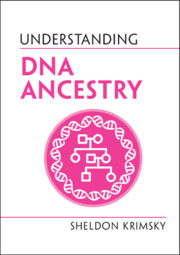Book contents
- Understanding DNA Ancestry
- Series page
- Understanding DNA Ancestry
- Copyright page
- Reviews
- Dedication
- Contents
- Foreword
- Acknowledgments
- 1 Introduction
- 2 The Business of DNA Ancestry
- 3 What Our Genomes Tell Us about the Geographical Origins and Movements of Early Human Populations
- 4 The Science behind DNA Ancestry Testing
- 5 Ancestry Informative Markers
- 6 Ancestry DNA Population Reference Panels
- 7 Comparing a Donor’s DNA to Reference Panel Populations
- 8 Probing Your DNA
- 9 Forensic Applications of Ancestry DNA Results
- 10 Privacy, Personal Identity, and Legal Issues
- 11 Discovering Unknown, Missing, or Mistaken Relatives
- 12 Accuracy, Consistency, and Validation of DNA Ancestry Tests
- 13 Conclusion
- Summary of Common Misunderstandings
- References
- Index
- Other books authored, coauthored, or coedited by Sheldon Krimsky
3 - What Our Genomes Tell Us about the Geographical Origins and Movements of Early Human Populations
Published online by Cambridge University Press: 05 March 2022
- Understanding DNA Ancestry
- Series page
- Understanding DNA Ancestry
- Copyright page
- Reviews
- Dedication
- Contents
- Foreword
- Acknowledgments
- 1 Introduction
- 2 The Business of DNA Ancestry
- 3 What Our Genomes Tell Us about the Geographical Origins and Movements of Early Human Populations
- 4 The Science behind DNA Ancestry Testing
- 5 Ancestry Informative Markers
- 6 Ancestry DNA Population Reference Panels
- 7 Comparing a Donor’s DNA to Reference Panel Populations
- 8 Probing Your DNA
- 9 Forensic Applications of Ancestry DNA Results
- 10 Privacy, Personal Identity, and Legal Issues
- 11 Discovering Unknown, Missing, or Mistaken Relatives
- 12 Accuracy, Consistency, and Validation of DNA Ancestry Tests
- 13 Conclusion
- Summary of Common Misunderstandings
- References
- Index
- Other books authored, coauthored, or coedited by Sheldon Krimsky
Summary
The purpose of DNA ancestry genealogy is to determine what the geographical origins are of an individual’s ancestry, regardless of where he or she is currently living. The scientific premise behind this exercise is that people’s DNA contains sequences of their ancestors’ DNA, which can be traced back hundreds or even thousands of years, and that their ancestors were settled in a region of the world that remained relatively isolated. This isolation allowed ancient populations to remain inbred within certain geographical parameters. Inbreeding is the mating of humans closely related by ancestry. It is more likely to occur in isolated, non-migrating populations, resulting in a loss of genetic diversity and a high incidence of birth defects. Mutations in the DNA circulating within these inbred populations can provide a genetic fingerprint of the geographical region in which they were located.
Keywords
- Type
- Chapter
- Information
- Understanding DNA Ancestry , pp. 17 - 25Publisher: Cambridge University PressPrint publication year: 2021

